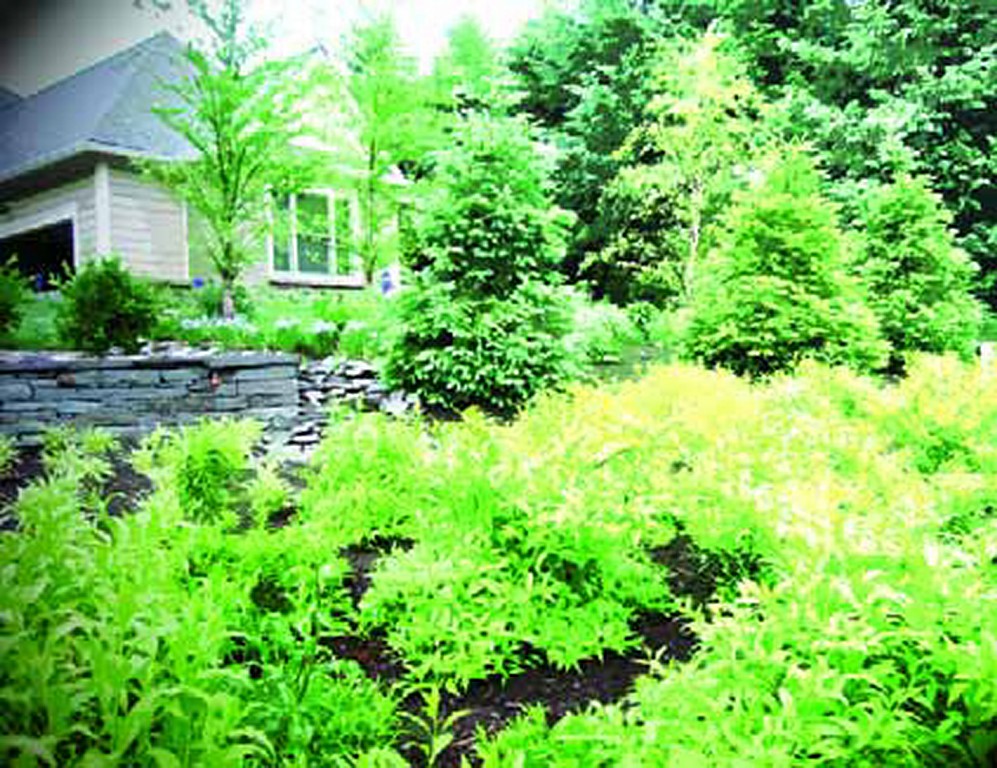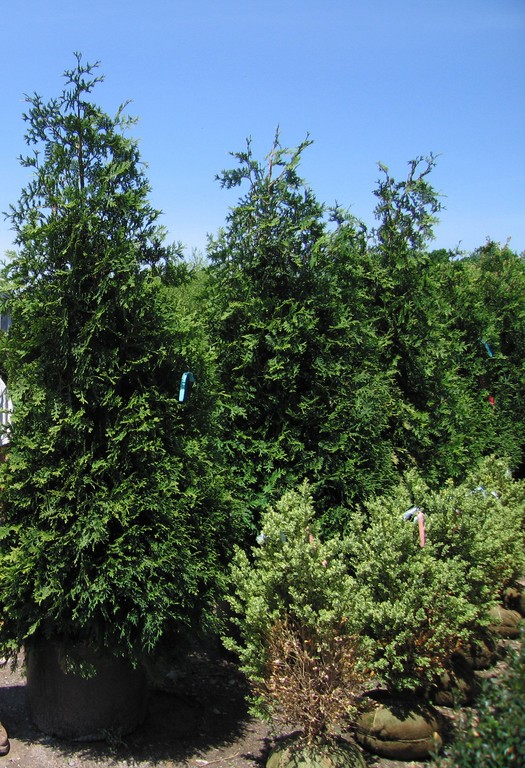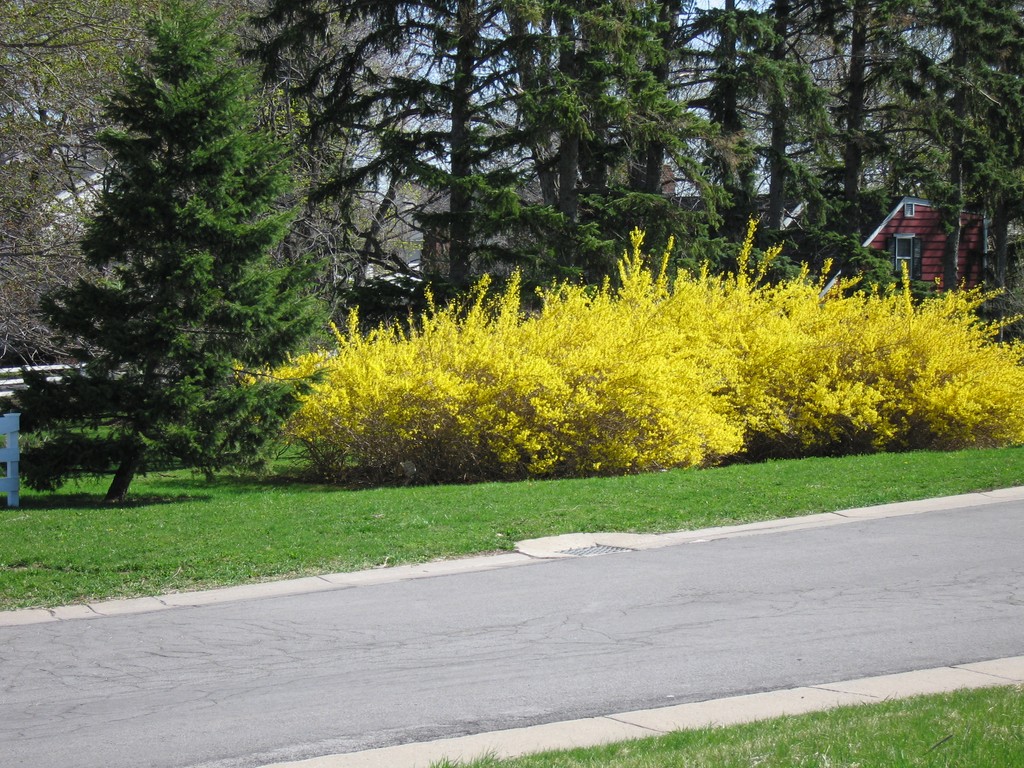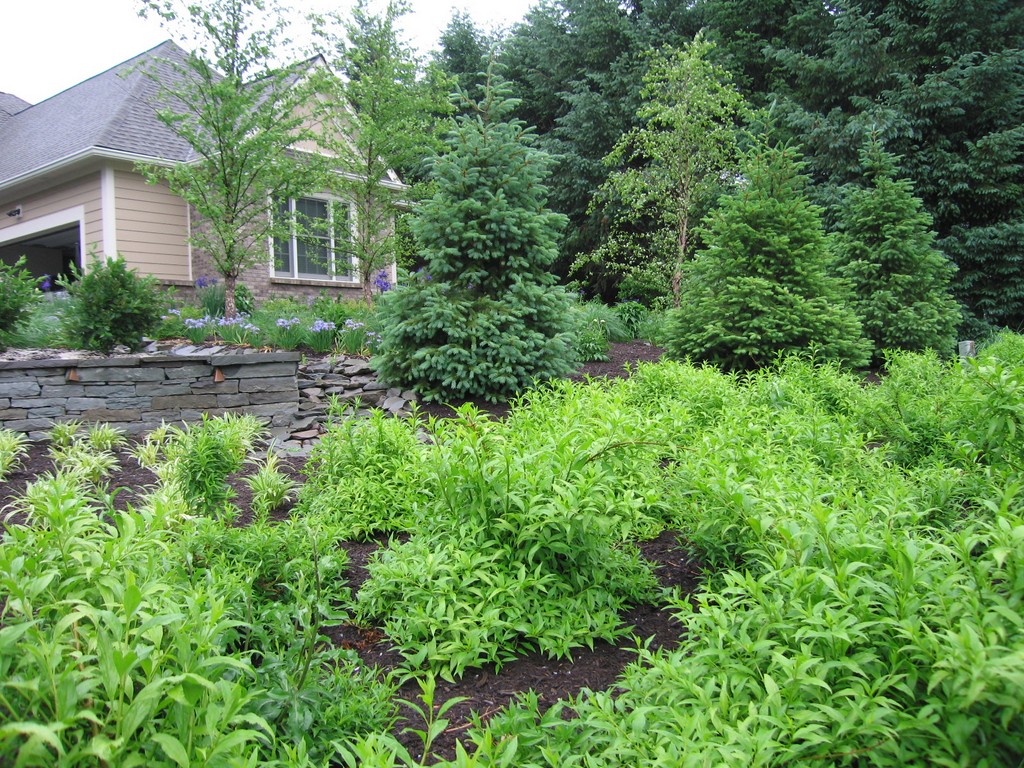The Evergreen Scene

Where I work in the northeastern United States, several species of trees and shrubs have been staples of residential landscape design for so long that stands of these arboreal mainstays (very often deployed by firms not known for their creativity) have become something of a visual cliché.
Through the years, however, I’ve found that even these shopworn landscape icons can be used in beautiful and often surprising ways that seem perfectly suited to their environments while also making elegant statements.
Case in point: I was recently making a final design presentation to a client in which we were covering the last details of a grand plan that had included installation of a pool, Travertine decks, a custom outdoor kitchen, retaining walls, a fire pit and an outdoor lighting system. The project had been under development for several years by that time, and the client and I had a good, well-established working relationship.
As we worked through details of the planting plan during our meeting, it struck me that this yard would serve as a perfect occasion for using one of the most shopworn of all evergreens.
NO AFTERTHOUGHT
On a project of this complexity, I almost invariably offer generic plant specifications at the outset because, in my experience, this is the one phase of a large project that is most subject to change in some way or other.
My reasoning is simple: We want to make certain that what we design (and ultimately install) plant-wise will suit the site exactly. As I see it, it doesn’t make sense to get specific about plantings until the pool and its associated structures have actually been placed and completed. Only then do we go in, survey the scene and decide in very specific terms what to plant and where.
As we conducted our final review in this case, it became clear that privacy was this client’s paramount concern, and for good reason: The home sat on a typical half-acre lot in a fairly typical subdivision. We’d preserved some established trees to one side of the property, which meant we ended up positioning the pool within 20 feet of the opposite lot line with five feet of Travertine decking beyond.
| Of all the available arborvitaes, Green Giant is the best for use when you want to achieve a specimen effect and is, in my book, the most beautiful of what is too often dismissed as an overused species. |
The client was set on placing a perimeter fence five feet inside the lot line, which left us with ten feet of space in which to create a privacy screen. To do so, evergreens were the logical choice.
The neighbor’s home is a corner lot, so from the pool and deck one looks across the adjacent backyard to a roadway – and on to a half-dozen other homes on the street beyond. The perimeter fence was to be an aluminum model from Jerith Mfg. Co. (Philadelphia) that would swing around to enclose the pool as well, but it was in an openwork style that offered no privacy at all.
As we stood on the pool terrace looking out across the neighbor’s yard, my client flatly declared, “I want this completely blocked out with evergreens.” It made perfect sense to me and I knew what I wanted to do right away. I just needed to explain myself in full before he could automatically say no.
Why was I worried? It was because I wanted to fill the space with the overused, passé, totally boring Arborvitae. As I quickly explained to my client, I wanted to use something common in an uncommon way simply by considering different varieties of these evergreens than are usually seen in residential designs.
I’ve worked in the northeast my entire career, so I’ve seen more than my share of landscapes planted with row upon row of Emerald Green or Dark American Arborvitae. These trees grow in an upright, multi-stem fashion and take on the look of exploded cigars when snow falls on them. For the rest of the year, local deer populations sculpt what’s left into green mushrooms, completely defoliating their lower halves.
So why do designers use them? My suspicion is that it’s a matter of habit: They’re well known, familiar, widely available and well suited to planting in tight areas where fences aren’t an option. By default, it seems, they’ve endured as the plant of choice.
BREAKING A MOLD
Certain other evergreens have also become cliché in applications beyond privacy screening. In the 1960s, for example, it was all the rage among landscape companies to install various forms of yew as foundation plantings in front of homes.
In these cases, the most commonly used plant was the common Densiformis yew. After a few years, they fell out of favor and homeowners started inserting some color by using inexpensive plants such as Forsythia (more on these below). The problem is, these plants tend to grow to large sizes – leaving unhappy homeowners to devote their summers to keeping them at bay.
| Newly planted Dwarf Yew (at left) is small and unassuming – and will stay that way for many years after installation: The one on the right, for example, was planted five years ago, has never seen hedge clippers – and never will. |
There are, of course, options to these visual disasters, and I was proposing to my client that we take one by selecting a mix of Green Giant Arborvitae (Thuja plicata “Green Giant”) along with some grasses as a groundcover. Unlike the more common Arborvitae mentioned above, Green Giant grows in an upright, pyramidal shape with a single leader. It has a classic cedar-leaf pattern that whirls out of the plant as a beautifully textured detail.
Given its growth habits and visual character, I saw using Green Giant not only as a privacy screen, but also as a wind-break and as a nice run of specimen trees: Indeed, even small groupings of these trees make dramatic statements in open spaces as they grow quickly to heights of about 40 feet and widths of about 15 feet. That may seem large, but it really isn’t by comparison to other common evergreens such as spruces or pines.
| Although overused, Forsythia can be a great plant. This, for example, is Lynwood Gold Forsythia the way it should be kept: Left on its own, it will grow up to 15 feet tall and will never need pruning. |
To me, Green Giant Arborvitae may well be the most beautiful of the species, a graceful green cone that looks great year ’round and doesn’t splay out with the first snowfall.
If privacy were the sole issue, I could have supplemented the Arborvitae with Hick’s yew (Taxus media Hicksii): If left unpruned, they grow to about twelve feet tall and six feet wide, but they reach that full size only slowly and require a good bit of maintenance pruning to keep them in check (a fact that makes them generally unsuitable as foundation plantings). We didn’t make this choice in any event because my client wanted the view cut off sooner rather than later.
We also might have used Dwarf (or Weeping) English yew (Taxus baccata repandens), a beautiful flowing plant that grows to no more than three feet tall and about five feet wide (although there are some larger specimens in New York’s Central Park) to fill in under the trees. This is a plant much valued for its low, flowing appearance and its pruning-free maintenance.
At times, I’ve used it to mimic the effect of green rolling hills, and large groupings take on a spectacular look when it snows. Indeed, this plant has no equal when paired with Japanese Forest Grass (Hakonechloa macra aureola) alongside a shady creek or pond: The weeping characteristic mimics the look of water cascading over rocks.
The key here is that these plants provided my client with a near-instant sense of privacy that was both effortless to achieve and perfect for the setting.
ANOTHER PLAYER
In listing overused plants just above, I mentioned Forsythia. It’s not an evergreen, but it’s another plant that fits into this discussion because it can be either a nightmarish cliché – or can help in creating a distinctive garden space.
Not long ago, I shocked one of my clients who wanted to establish some privacy along the “back forty” of her property by recommending a common Forsythia called Lynwood Gold. The area in question was at the top of a rise from which her neighbors had an open view into her yard. I suggested Lynwood Gold as a relatively inexpensive plant that would give her near-instant gratification – rapid growth to about 15 feet tall and wide with no need for pruning.
| In full bloom or not, Gold Tide Forsythia forms a great ground cover that won’t grow to be more than four feet tall. |
In another context, this would not have been the right choice. Far too often, Forsythia is planted right against a home’s foundation and ends up being pruned into lollipop or bowling-ball shapes to keep it in check. But if the setting is right and the client agrees, I won’t hesitate to use Lynwood Gold or Gold Tide (Forsythia ‘Courtasol’ Gold Tide) – a variety that grows to about three or four feet tall and about six feet wide and serves well as a massing groundcover or as an individual specimen near a foundation. It’s a tough plant that flowers early in the spring, then acts as a foil for other flowering plants throughout the season.
My point here is that plants often become cliché through no fault of their own. Instead, they’re victims of landscape designers and homeowners who use them without thought, imagination or creativity.
To me, choosing just the right plant for just the right place is the basic challenge of landscape design: To do no more than fall in line with trends or settle for what’s most readily available is simple professional laziness. By keeping an open mind and by focusing on the needs of a setting and the client, you can break the shackles of conventionality, breathe new life into seemingly tired species and make your clients happy at the same time.
Bruce Zaretsky is president of Zaretsky and Associates, a landscape design/construction/consultation company in Rochester, N.Y. Nationally recognized for creative and inspiring residential landscapes, he also works with healthcare facilities, nursing homes and local municipalities in conceiving and installing healing and meditation gardens. You can reach him at [email protected].
















